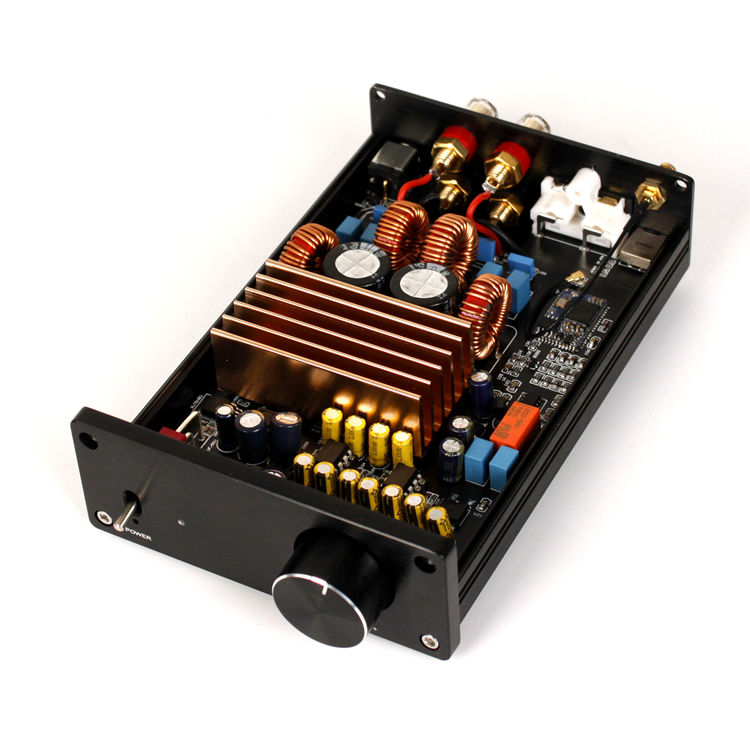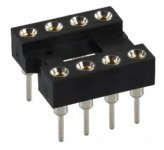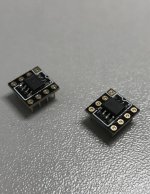Nothing needs to be changed on the DAC, just to make an interconnect cable with an XLR at one end and an 8-pin adapter at the other end.
The XLR goes to the DAC and the 8-pin adapter goes into the amplifier to replace the existing op-amp.
The XLR goes to the DAC and the 8-pin adapter goes into the amplifier to replace the existing op-amp.
Attachments
Nothing needs to be changed on the DAC, just to make an interconnect cable with an XLR at one end and an 8-pin adapter at the other end.
The XLR goes to the DAC and the 8-pin adapter goes into the amplifier to replace the existing op-amp.
Given the price of my dac) I don't prefer to venture into unknown territory 😀
It's not really unknown territory. Several members here, including myself, have bypassed the opamps of these amplifiers.
zek is correct, you would need to make up two cables which are female XLR to DIP8 socket adapter.
Wiring at the DIP8 socket is to the pins where the opamp has its two outputs, plus AGND. So as per the NE5532 pinout from the datasheet, this will be your wiring:
+ve XLR-F pin 2 (red) to DIP8 pin 1
-ve XLR-F pin 3 (white) to DIP8 pin 7
AGND XLR-F pin 1 (braid) to DIP8 pin 4
zek is correct, you would need to make up two cables which are female XLR to DIP8 socket adapter.
Wiring at the DIP8 socket is to the pins where the opamp has its two outputs, plus AGND. So as per the NE5532 pinout from the datasheet, this will be your wiring:
+ve XLR-F pin 2 (red) to DIP8 pin 1
-ve XLR-F pin 3 (white) to DIP8 pin 7
AGND XLR-F pin 1 (braid) to DIP8 pin 4
Attachments
Last edited:
It's not really unknown territory. Several members here, including myself, have bypassed the opamps of these amplifiers.
zek is correct, you would need to make up two cables which are female XLR to DIP8 socket adapter.
Wiring at the DIP8 socket is to the pins where the opamp has its two outputs, plus AGND. So as per the NE5532 pinout from the datasheet, this will be your wiring:
+ve XLR-F pin 2 (red) to DIP8 pin 1
-ve XLR-F pin 3 (white) to DIP8 pin 7
AGND XLR-F pin 1 (braid) to DIP8 pin 4
I take note of it but without conviction... I need to find a dip8 adapter and a XLR Plug. But many thanks for sharing.
By the way, any idea about this hypothesis : With a TPA3255 Amplifier equiped with Bluetooth chipset : I wonder if the signal received passes through the OP Amps or if it is directly transmitted to the TPA32XX chip ? in the second case, this could give us an idea of the sound with an unprocessed signal
Last edited:
DIP8 socket from Mouser -I need to find a dip8 adapter and an XLR Plug.
https://au.mouser.com/ProductDetail/Mill-Max/110-13-308-41-001000?qs=%2Fha2pyFadugNqN7TEfSg9dgVPVw4Cip4QS1IvzyqsD4nViX%252B7uIdxq0MjFrVtLjW
10x DIP8 sockets from China -
10pcs 8Pin DIP-8 SIP Round IC Sockets Adaptor Solder Type IL | eBay
XLR plugs are all over eBay, or your local pro-music shop. Or from Mouser -
https://au.mouser.com/ProductDetail/Neutrik/NC3FXX?qs=sGAEpiMZZMv0W4pxf2HiV1SJfrv4woLT9X2Ff%2FA3REo%3D
I see in the datasheets that bluetooth receiver chips can be configured either for single-ended or differential analogue output, so it's certainly feasible ...With a TPA3255 Amplifier equiped with Bluetooth chipset : I wonder if the signal received passes through the OP Amps or if it is directly transmitted to the TPA32XX chip ?
but I see no sensible reason why the designer of the amp would route the analogue output of the bluetooth receiver any differently than the normal analogue inputs of the amp.
If this is the amplifier you are referring to -
Tpa3255 Bluetooth 5.0 Digital Audio Amplifier 325Wx2 High Power Class D 2.0 Channel Amp Dac Pcm5102 Decoding For Phone| | - AliExpress
that particular amp includes a PCM5102 DAC chip, which I presume is for the bluetooth receiver (that's a good feature IMO) and the PCM5102 chip has single-ended analogue outputs only, so in this case the answer is clear - the outputs of the PCM5102 must go via the opamp front end.
DIP8 socket from Mouser -
110-13-308-41-001000 Mill-Max | Mouser Australia
10x DIP8 sockets from China -
10pcs 8Pin DIP-8 SIP Round IC Sockets Adaptor Solder Type IL | eBay
XLR plugs are all over eBay, or your local pro-music shop. Or from Mouser -
NC3FXX Neutrik | Mouser Australia
I see in the datasheets that bluetooth receiver chips can be configured either for single-ended or differential analogue output, so it's certainly feasible ...
but I see no sensible reason why the designer of the amp would route the analogue output of the bluetooth receiver any differently than the normal analogue inputs of the amp.
If this is the amplifier you are referring to -
Tpa3255 Bluetooth 5.0 Digital Audio Amplifier 325Wx2 High Power Class D 2.0 Channel Amp Dac Pcm5102 Decoding For Phone| | - AliExpress
that particular amp includes a PCM5102 DAC chip, which I presume is for the bluetooth receiver (that's a good feature IMO) and the PCM5102 chip has single-ended analogue outputs only, so in this case the answer is clear - the outputs of the PCM5102 must go via the opamp front end.
Hi thanks for the links. I will take a look.
I was refering to that one or this one as well :

Ok amigos, I found some old parts on my stock...
need to find a second XLR now lol
Looks correct for you ?

need to find a second XLR now lol
Looks correct for you ?

Last edited:
At first glance I was concerned to see a black wire NOT being used for the GND connection,
but apart from that, yes, your connections are correct.
but apart from that, yes, your connections are correct.
Regarding your female XLR plug - be careful when plugging it into your DAC - since the rear locking ring is missing, the central plastic core is likely to be pushed back, and may fail to make good contact with the male XLR pins.
You will probably need to hold your finger against the rear of this core as you plug it in.
You will probably need to hold your finger against the rear of this core as you plug it in.
Hi Danny,
Back online, things are moving quickly here 🙂
No real reason to doubt what has been posted previously, but just to make sure your op-amps are power supplied as per the TI data sheet, that is "+ and ground" and not with a negative voltage instead of the ground as in some builts...
I would advise you check that DIP8's pin 4 is indeed ground of your unit (eg continuity with your RCA mass, possibly case etc. or any other ground point, of course unit swicthed off). It is VERY likely to be the case, but as others here seem to have experimented on another board, better safe than sorry...
If it is not the case, there are also easy fixes, but again no reason, just chek to make sure before trying
Claude
Claude
Back online, things are moving quickly here 🙂
No real reason to doubt what has been posted previously, but just to make sure your op-amps are power supplied as per the TI data sheet, that is "+ and ground" and not with a negative voltage instead of the ground as in some builts...
I would advise you check that DIP8's pin 4 is indeed ground of your unit (eg continuity with your RCA mass, possibly case etc. or any other ground point, of course unit swicthed off). It is VERY likely to be the case, but as others here seem to have experimented on another board, better safe than sorry...
If it is not the case, there are also easy fixes, but again no reason, just chek to make sure before trying
Claude
Claude
Hi amigos,
If there is a lower risk in handling ... I will not attempt the operation.
I imagine that the whole point of this test is to check the "raw" sound of the amplifier?
I see the OP Amps as Tubes. This is precisely the interest of this amp: being able to switch the OP Amps and find "his sound". This is one of the reasons why I liked it right away. I remember when I owned my tubes preamp, I tested 10 different valves before finding "the sound" I was looking for ....
I want to propose you something guys!
Would you like to create a collective money pot which would allow us to send our "favorite amplifiers" to Audio Science Review. It would be an interesting step since we could have tangible results and free from any subjectivity.
Exemple : AIYIMA TPA3251 bought in the US about $50 + some OPA1656 ($15) + Shipping cost $15 = $80 (about)
If at least 10 members play the game, this would allow us to theoretically test our favorite amps for a a meager participation
Either we send the money directly to the tester so he can buy it or or we designate an American member who can buy then send the material. In order not to be jealous, the material is recovered by the one who has made the effort to send it.
If there is a lower risk in handling ... I will not attempt the operation.
I imagine that the whole point of this test is to check the "raw" sound of the amplifier?
I see the OP Amps as Tubes. This is precisely the interest of this amp: being able to switch the OP Amps and find "his sound". This is one of the reasons why I liked it right away. I remember when I owned my tubes preamp, I tested 10 different valves before finding "the sound" I was looking for ....
I want to propose you something guys!
Would you like to create a collective money pot which would allow us to send our "favorite amplifiers" to Audio Science Review. It would be an interesting step since we could have tangible results and free from any subjectivity.
Exemple : AIYIMA TPA3251 bought in the US about $50 + some OPA1656 ($15) + Shipping cost $15 = $80 (about)
If at least 10 members play the game, this would allow us to theoretically test our favorite amps for a a meager participation
Either we send the money directly to the tester so he can buy it or or we designate an American member who can buy then send the material. In order not to be jealous, the material is recovered by the one who has made the effort to send it.
Last edited:
I forgot to share amigos,
The TI TPA3251 EVM was fully measured and tested below (Setup QA401 Audio Analyser recognized as reliable by Audio Science Review)... so I really wonder what the AIYIMA TPA3251 / OPA1656 could give for comparison
The one for the TI 3251 EVM :
First Look: Evaluating Class D Power Amps with the QA401
The one for the TI 3255 EVM here :
TI TPA3255 EVM
– QuantAsylum
The TI TPA3251 EVM was fully measured and tested below (Setup QA401 Audio Analyser recognized as reliable by Audio Science Review)... so I really wonder what the AIYIMA TPA3251 / OPA1656 could give for comparison
The one for the TI 3251 EVM :
First Look: Evaluating Class D Power Amps with the QA401
The one for the TI 3255 EVM here :
TI TPA3255 EVM
– QuantAsylum
Last edited:
Yes, sensible idea.I would advise you check that DIP8's pin 4 is indeed ground of your unit (eg continuity with your RCA mass, possibly case etc. or any other ground point, of course unit swicthed off).
Just check with a multimeter as ClaudeG explained. If pin 4 is not AGND, there are many other AGND points you could connect to.If there is a lower risk in handling ... I will not attempt the operation.
Risk is very low, there are still DC blocking caps between the opamp connections and the TPA3251 chip.
"Raw" is an overstatement. You can buy TPA3116 amps with/without opamp frontends, but no one refers to the opamp-free TPA3116 amps as "raw". "Direct" is more the case.I imagine that the whole point of this test is to check the "raw" sound of the amplifier?
As with any power amp, you should consider what type, and how many preamp/buffer stages you have between your source and power amp.
"Raw" is an overstatement. You can buy TPA3116 amps with/without opamp frontends, but no one refers to the opamp-free TPA3116 amps as "raw". "Direct" is more the case.
As with any power amp, you should consider what type, and how many preamp/buffer stages you have between your source and power amp.
Suggestion : I am very interested in the TPA3255's JLElectronicsPh board.
I am almost sure we can ask the designer to bypass the OP Amps on their pre-prod. boards. They are normally sold with OPA1656 on it (DIP8 or SOP8).
Would you like me to ask to the designer If I can get it without any OP Amps installed and bypass the buffer ?
Last edited:
Wait, I can't guarantee that you will prefer the sound of a direct-input TPA3251 ! It's feasible that it may sound too "dry" or "relaxed" for you.I am almost sure we can ask the designer to bypass the OP Amps on their pre-prod. boards.
That's why I think you first need to audition it with your AIYIMA.
Hi amigos,
If there is a lower risk in handling ... I will not attempt the operation.
I imagine that the whole point of this test is to check the "raw" sound of the amplifier?
I see the OP Amps as Tubes. This is precisely the interest of this amp: being able to switch the OP Amps and find "his sound". This is one of the reasons why I liked it right away. I remember when I owned my tubes preamp, I tested 10 different valves before finding "the sound" I was looking for ....
I want to propose you something guys!
Would you like to create a collective money pot which would allow us to send our "favorite amplifiers" to Audio Science Review. It would be an interesting step since we could have tangible results and free from any subjectivity.
Exemple : AIYIMA TPA3251 bought in the US about $50 + some OPA1656 ($15) + Shipping cost $15 = $80 (about)
If at least 10 members play the game, this would allow us to theoretically test our favorite amps for a a meager participation
Either we send the money directly to the tester so he can buy it or or we designate an American member who can buy then send the material. In order not to be jealous, the material is recovered by the one who has made the effort to send it.
Whilst admiring your undoubted enthusiasm, I wonder what you hope to achieve? I'm sure there are members on this forum who could undertake such tests, and interpret the results. However, if the tests showed a 'poor' set of results, would that mean that you, Rhing etc would enjoy your amp less?
Whilst admiring your undoubted enthusiasm, I wonder what you hope to achieve? I'm sure there are members on this forum who could undertake such tests, and interpret the results. However, if the tests showed a 'poor' set of results, would that mean that you, Rhing etc would enjoy your amp less?
I see in this maneuver an opportunity to measure our doubts. However, the only amp I haven't sold is my TPA3251)
If indeed the tests showed a bad measure ... I would admit that I have absolutely imperfect ears ... like the common man)
Apart from that: I have often been asked if I could bring concrete measures when I expressed my opinions ... so why not offer the possibility to inform members to know the measures relating to this amp?
UPDATE READ PLEASE : Any US Member here who own this AIYIMA TPA3251 and who would like to lend it to Audio Science Review? I take care of the shipping cost (
if it does not exceed the price of the amp) If yes : send me a private message please
Last edited:
I will send you a PM daniboun. I don’t have the proper test equipment set up to measure Class D amplifiers. All I can offer at this point is that this little amp sounds very good.
On another note, I received the OPA1656 op amps today, so I will solder then onto the BrownDog DIP8 adapters and try them out.
On another note, I received the OPA1656 op amps today, so I will solder then onto the BrownDog DIP8 adapters and try them out.
I will send you a PM daniboun. I don’t have the proper test equipment set up to measure Class D amplifiers. All I can offer at this point is that this little amp sounds very good.
On another note, I received the OPA1656 op amps today, so I will solder then onto the BrownDog DIP8 adapters and try them out.
Nice thanks Rhing. Waiting for you private message.
Let us know if you feel any improvement with those OPA1656 and what about the MA5173-AE coilcrafts ?
- Home
- Amplifiers
- Class D
- TPA3251d2



